Key Components of Smart Building Software
How IoT is Reshaping Smart Building Software
Benefits of Smart Building Management with IoT
We all want to make our lives more comfortable and our surroundings more pleasant and efficient. That’s true not only for our homes but also where we go to work and play.
It used to be that we had to adapt our way of doing things to the spaces we occupy. But these days, we increasingly expect our environment to adapt to us. Technology has the power to make cities and the buildings in them safer and more comfortable.
That’s why the concept of smart buildings is gaining popularity. According to recent data, the size of the global smart buildings market was valued $67,6 billion in 2021 and is expected to reach $328.6 billion by the end of 2029.
Key Components of Smart Building Software
How IoT is Reshaping Smart Building Software
Benefits of Smart Building Management with IoT
Modern technologies help create efficient, easy-to-manage places where people can find everything they need. The good news is that smart buildings not only make residents more comfortable but also offer advantages to owners and managers.
Keep reading this article to learn more about:
A smart building is a building that self-regulates its environment, enables economical use of resources, and creates a safe and comfortable atmosphere for tenants, all with the use of modern technologies such as:
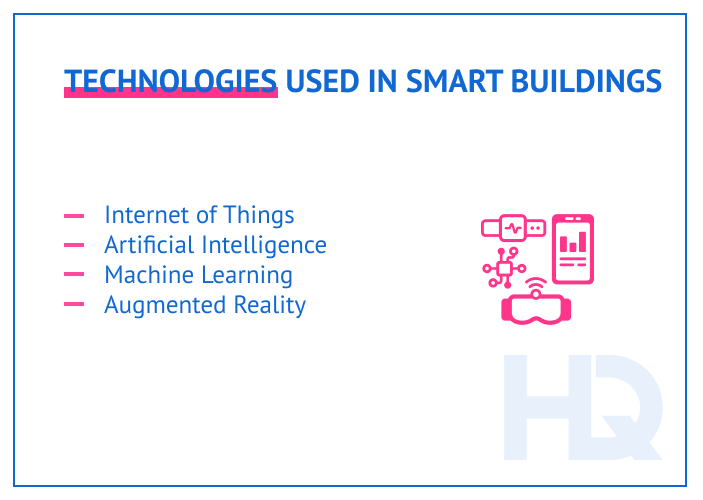
Smart buildings are often non-residential buildings, such as offices, shopping centers, industrial buildings, airports, and others.
The concept of smart building follows a user-centric approach that seeks to make the building as efficient as possible over its lifetime. A smart building is designed to automate building operations and reduce the need for human interference.
A smart building:
To meet modern requirements and standards in the building industry, facility owners should stay up to date and implement progressive smart building technologies in their buildings.
So, let’s take a closer look at systems and technologies that can turn an ordinary building into a smart one.
We’ll explore one of the most important elements of smart building—smart building software.
Smart building software is a set of solutions and platforms that use a one-platform approach to control all building systems. It’s like a computer-based manager that assigns commands to numerous electronic systems in the building and controls their performance.
A platform interacts with supervisory hardware, such as sensors, controllers, displays, and others.
Smart building software is often used to manage the:
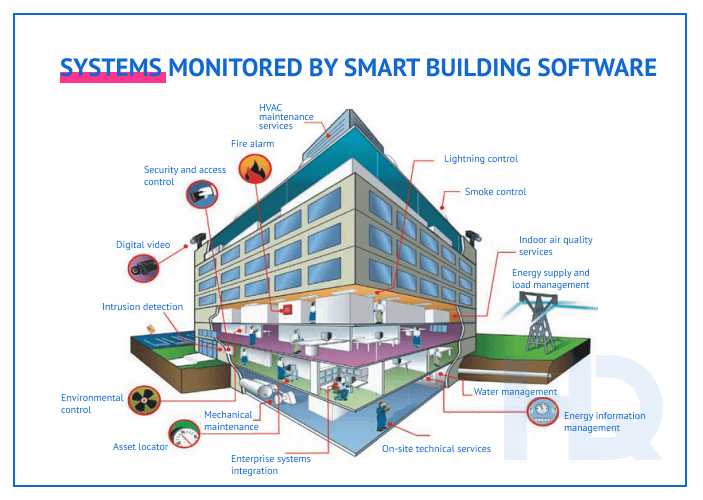
In addition to controlling building systems, a platform’s responsibilities may include diagnostics, energy consumption management, and data reporting. All this requires integration with several aspects of building operations, including:
Smart building software opens up a wide range of advantages to its users.
A smart building platform can:
Most of these benefits are achieved through the use of Internet of Things technologies.
Let’s look in more detail at some of the ways IoT works with software to improve building management.
Using IoT in conjunction with custom smart building software provides facility owners with a feature-rich platform with potential connection to multiple clouds. Top-notch technologies help collect useful information faster, ensure data security, and reduce deployment costs. They are also necessary for remote control and automation.
Also, smart building IoT solutions can collect data outside the building, which allows for outdoor surveillance, parking management, and so on.
Technological advancements have led to a variety of Internet of Things solutions that can work with you to build smart software or extend its features. We’ll take a closer look at some of them below.
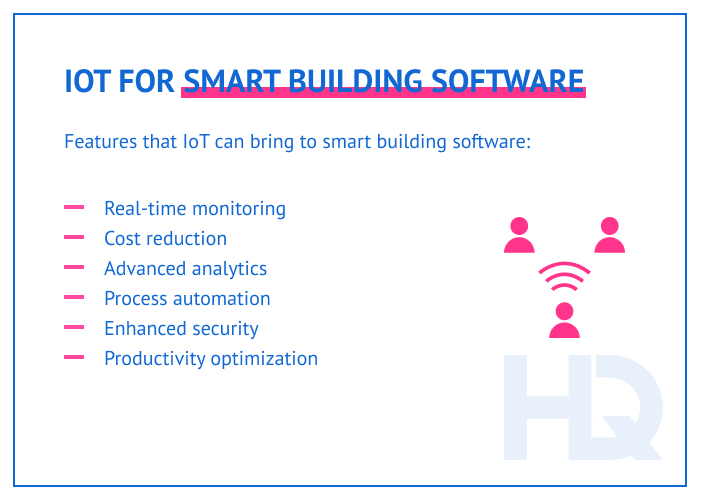
IoT technologies allow a smart building app to connect to many systems and easily integrate new ones.
Also, IoT provides permanent, real-time monitoring and data gathering. Deploying IoT devices allows analytical systems to gather a vast amount of information for analysis, and the building software can perform advanced diagnostics and accurate fault detection.
For example, the app allows a manager to quickly detect and isolate broken mechanisms, which means the problem can be fixed quickly and associated systems can be protected from failure.
IoT solutions for smart buildings in real estate – custom development at your serviceHQSoftware has a team of skilled professionals ready to tackle the project. Let’s talk!
Julia Tuskal
Head of Sales
at HQSoftware
As smart IoT technologies provide real-time monitoring of HVAC, the facility manager can use the system effectively to eliminate overheating or underheating and reduce energy consumption.
Motion detectors can monitor whether people are in a particular room and switch off lights when no one is present, which means less wasted energy and lower utility costs for tenants.
In financial reports provided by the smart building platform, users can see how much money they’ve saved through smart energy consumption.
So, IoT may not only decrease building operating costs but also cut greenhouse gas emissions.
Thanks to strict smart building control of energy consumption and solar panels, the Crystal building in London, for example, produces 70% fewer carbon emissions than similar office buildings in the UK.
A smart building platform provides users with advanced analytics using data collected by IoT sensors. This information is useful for detecting equipment vulnerabilities and providing predictive maintenance. Armed with this information, facility managers don’t have to wait for equipment to fail but can take measures to prevent breakdowns in the first place.
The world-famous Burj Khalifa in Dubai, for instance, gathers real-time data and sends it to an IoT platform that analyzes the information and identifies maintenance issues. With the help of analytics technologies, facility managers at Burj Khalifa have reduced the hours spent on maintenance by 40 percent.
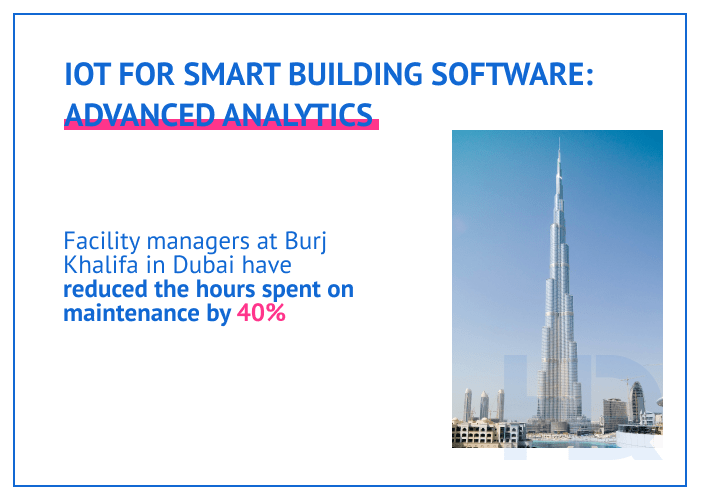
Data analysis can also create comprehensive building reports, suggest solutions to increase the building’s efficiency, and improve the comfort of building tenants.
IoT technologies allow automation of many processes, which reduces manual work and enhances operational performance.
With real-time monitoring, an IoT building automation system can measure the CO2 level in premises and automatically turn on ventilation when the level increases.
This method is used in the Capital Tower in Singapore. IoT sensors control overcrowding, constantly monitor the level of carbon dioxide, and automatically reduce it to values that ensure optimal air quality.
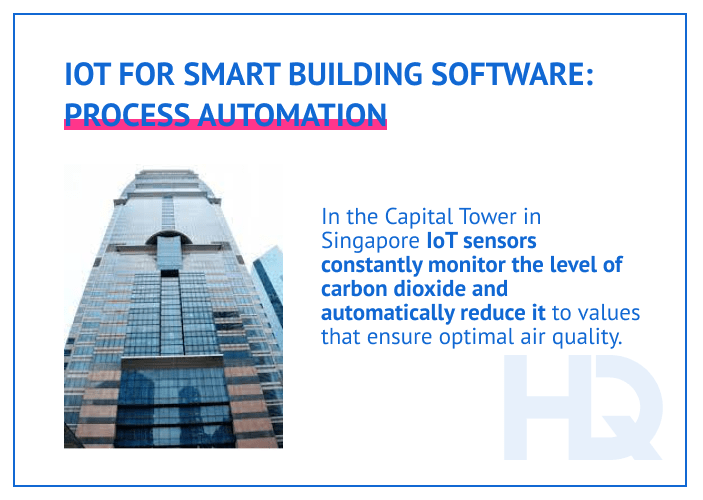
Smart building software is also useful for workers who maintain and repair building systems. They can use the platform to quickly detect system problems, fix them, and record what has been installed or repaired, making the work of other technicians easier.
Smart IoT systems that include motion detectors, facial and behavioral recognition, and imaging sensors can enhance smart building security. For example, sensors monitor how many people enter and leave the building, while video analytics solutions can be used to identify them. In case of suspicious activities, the platform can alert the building’s owners.
Also, a smart building management app gives residents the ability to control activities on their premises remotely and regulate access to particular areas.
With the help of IoT, a smart building platform can create an occupancy map. This enables people to use their building space more effectively and plan maintenance and cleaning activities when they won’t disturb people on the premises. This increases the speed and quality of the building staff work.
For example, employees of Frasers Tower in Singapore can easily determine how many people are in a particular room, find unoccupied space, and book facilities in real-time.
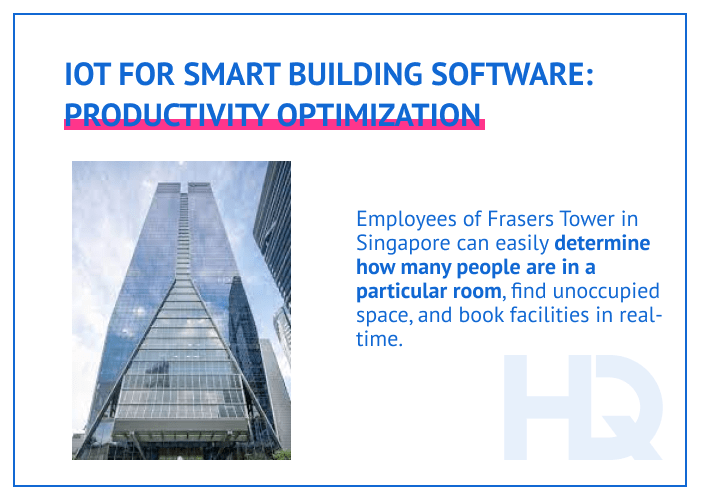
Also, smart building software provides a smart parking system that helps incoming drivers quickly find a vacant parking spot, ensuring a positive tenant experience.
Now that we’ve reviewed various ways of upgrading smart building software with the help of IoT, let’s discuss the advantages of IoT technologies in smart building management.
Using Internet of Things technologies for intelligent building management systems provides the ability to:
As you can see, IoT implementation helps create a progressive and comfortable place to which people will be happy to return, whether it’s where they live or where they work.
But how do people in a smart building make the best use of these qualities—for example, with a mobile application?
Mobile apps are a convenient way to ensure that all tenants, not only managers, can take full advantage of the capabilities of smart buildings. Such apps connect to IoT or other technologies and allow for managing them easily.
Different kinds of functions will be available to users of the building, depending on their role.
For example, residents can get remote control of their space and organize its environment according to their preferences, including temperature level, humidity, and more.
Facility managers and owners, in turn, can use the app to monitor operations of all connected building systems and control their use of resources.
A mobile app can gather data on how tenants are using the app and conduct analytics, which helps building managers to understand tenants’ interests, provide better services, and improve decision-making.
Another benefit of smart building mobile apps is that they can automate administrative routines, for example, booking and paying for meeting rooms. Also, they help to create a strong building community by notifying users of news and events taking place in the building.

The HQSoftware team has developed such an application for smart building and yacht management. It’s a native, highly customizable, IoT mobile app for automated management of connected devices.
The application helps manage HVAC systems, surveillance cameras, smart locks, motion detectors, energy consumption, and more. If a certain operation requires time to complete, the application shows the progress of its execution in real time.
The intuitive, high-quality mobile application met all the needs of the customer and has been used successfully by their clients.
With the rising popularity of smart buildings, particularly in new construction, comes the need for special smart building software that simplifies the use and control of a smart building. By implementing IoT, which significantly extends the functionality of building systems, management becomes more efficient and effective.
Smart building management has become a necessity for those who want to increase the efficiency of their facility and provide comfort to residents. With the help of smart building software companies, building owners, managers, and tenants can get a platform that will increase their comfort while interacting with all the features of a smart building.
Of course, one more advantage is that such platforms aren’t only for residential buildings or offices but may also be suitable for factories, warehouses, and other kinds of buildings.
IoT technologies bring new opportunities for operations management and make facilities more pleasant places to live or work.

Lead Software Engineer
An experienced developer with a passion for IoT. Having participated in more than 20 Internet of Things projects, shares tips and tricks on connected software development.
We are open to seeing your business needs and determining the best solution. Complete this form, and receive a free personalized proposal from your dedicated manager.

Sergei Vardomatski
Founder